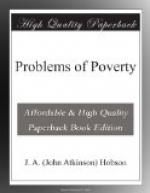Occasionally one of these sensational stories breaks into the light of day, through the public press, and shocks society at large, until it relapses into the consoling thought that such cases are exceptional. But those acquainted closely with the condition of our great cities know that there are thousands of such silent tragedies being played around us. In England the recorded deaths from starvation are vastly more numerous than in any other country. In 1880 the number for England is given as 101. In 1902 the number for London alone is 34. This is, of course, no adequate measure of the facts. For every recorded case there will be a hundred unrecorded cases where starvation is the practical immediate cause of death. The death-rate of children in the poorer districts of London is found to be nearly three times that which obtains among the richer neighbourhoods. Contemporary history has no darker page than that which records not the death-rate of children, but the conditions of child-life in our great cities. In setting down such facts and figures as may assist readers to adequately realize the nature and extent of poverty, it has seemed best to deal exclusively with the material aspects of poverty, which admit of some exactitude of measurement. The ugly and degrading surroundings of a life of poverty, the brutalizing influences of the unceasing struggle for bare subsistence, the utter absence of reasonable hope of improvement; in short, the whole subjective side of poverty is not less terrible because it defies statistics.
Sec. 7. Figures and Facts of Pauperism.—Since destitution is the lowest form of poverty, it is right to append to this statement of the facts of poverty some account of pauperism. Although chiefly owing to a stricter and wiser administration of the Poor Law in relation to outdoor relief, the number of paupers has steadily and considerably decreased, both in proportion to the population and absolutely, the number of those unable to support themselves is still deplorably large. In 1881 no less than one in ten of the total recorded deaths took place in workhouses, public hospitals, and lunatic asylums. In London the proportion is much greater and has increased during recent years. In 1901 out of 78,229 deaths in London, 13,009 took place in workhouses, 10,643 in public hospitals, and 349 in public asylums, making a total of 24,001. Comparing these figures with the total number of deaths, we find that in the richest city of the world 32.5 per cent., or one in three of the inhabitants, dies dependent on public charity. This estimate does not include those in receipt of outdoor relief. Moreover, it is an estimate which includes all classes. The proportion, taking the working-classes alone, must be even higher.




